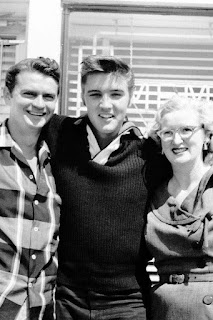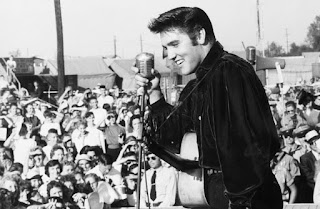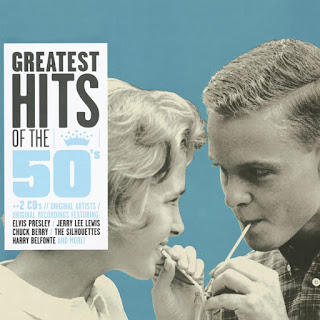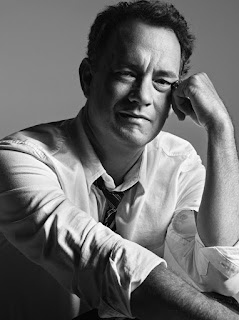Eileen Barton – Everybody's Buddy (Epic Records) – arranged by Marion Evans Orchestra (1957), written by Moose Charlap (Broadway composer best known for Peter Pan, 1954), with lyrics by Lee Adams.
Aesthetically, Buddy Holly might have been the most unlikely looking rock 'n' roll star of the 1950s. But he was, after Elvis Presley, unquestionably the most influential. In the fifties, Eisenhower was in the White House, Ricky loved Lucy, Pepsodent toothpaste erased the yellow teeth stains, and $10 in 1950 was equivalent in purchasing power to $104.44 in 2019. To be sure, in the whole VistaVision expanse of progress, stability, enlightenment, and shiny chromium plating, this new thing called rock 'n' roll was toiling to survive. Those three-chord tremolo rockabilly love ballads had a balm effect to counter the atomic bomb fears. Dave Laing's essay The Sound of Our Time (1969) implicitly promotes the idea of rock and roll in general, and Buddy Holly's music in particular, as an avant-garde art. In The Marxist Theory of Art (1978) Laing presents Julia Kristeva's account of the challenge the 'poetic language' of the literary avant-garde poses to Western culture. This challenge results from the way it contests the dominance of symbolic language, instead privileging semiotic communication, 'in the form of rhythms, intonations, lexical and rhetorical transformations'. Dave Laing had earlier noted the challenge posed by rock music to traditional Western song, specifically to the ballad, which until after the Second World War was the 'mainstay of popular song'. This ancient art form derived from the 'Courtly Code of Love' was formulated in mediaeval Western Europe. More specifically, Laing argues that Holly's distinctive vocal techniques undermine the coherence of the singing tone, on which the traditional ballad depends. 'Holly's approach was entirely new. The straight singing of a lyric is continually punctuated by exclamatory effects of various kinds. The voice suddenly swoops upwards or downwards, syllables are lengthened to cover three or more notes (as in 'ba-ay-by'), and sometimes phrases are spoken during instrumental solos'. In his analysis of Buddy Holly's vocal tecniques, Laing directly contrasts the traditional singer, who seeks 'to hold a note with maximum emotional effect', with Holly, who does not seem to seek that effect.
Few notes are held for more than one or two beats in Holly's records, so they avoid the overpowering emotion of the ballads typical of that period. Holly's listeners are not necessarily overwhelmed, as they used to feel by listening to a traditional ballad, but they have their attention redirected by the frequent changes of tone, pitch, and phrasing. For Laing, Holly's wide variety of vocal techniques is radical in that it precludes the sustained unity necessary for the representation of a homogeneous emotion. It is true that in ordinary usage an emotion, such as 'grief' or 'love', has to endure in time, unlike a sensation such as 'pain', which may be momentary (see Wittgenstein, 1968). Laing is in part justified in arguing that if Holly's style consistently avoids sustained notes, this constitutes a refusal of traditional sentimentality, since 'some of the vocal techniques Holly employs cannot be said to have emotional correlates in real life.' A transcendent type of idealisation of a woman is, in Laing's account, the prototype for the muses romantically celebrated throughout the traditional Western ballad. However, rock and roll music, too, conjures up idealisations of women, which become transcendent objects of veneration. Famous among them is Buddy Holly's 'Peggy Sue'. As Jonathan Cott says, Peggy Sue is "mysterious, hardly there," but she's revived and recreated in a succession of other songs: by Holly (in Peggy Sue Got Married), and subsequently by Bobby Darin, Ritchie Valens and the Beatles.
Holly's famous 'hiccup' signature, or in the sudden glides from deep bass to falsetto (and back again), reveals the child inside the man, and the man inside the child. Up to this point, the lyrics in "Peggy Sue" have performed a step-by-step narrative transformation, as follows: verse 1 boy talks to boy about his loneliness; verse 2 man expresses desire for woman in quasi-religious terms; verse 3 a father figure talks affectionately to an infantilized girl; verse 4 young man uncertainly confesses true love to a girl. In a sense, defences are progressively stripped away as the narrative approaches an actual encounter. He is excitedly anticipating the transition from talking about 'My Peggy Sue' to calling her that to her face. The same happens in bars 6-7 of verse 2, where the phrase is similarly ambiguous in facilitating a transition from addressing Peggy Sue as absent in the verse, to addressing her as present in the refrain. Here the excitement is increased by the further off-beat 'P'heggy' in the preceding phrase (the 'Oh P'heggy' of bars 4-5). But after bar 6 of verse 2, the off-beat 'P' never reappears.
Musically, the syncopation is here left unresolved, making 'Peggy Sue' sound like a question, or a call expecting a response. It is tempting to see the association of 'Sue', 'gal' and 'love' as indicating the femininity of the syncopated rhythms, with 'yes' being Sue's verbal response to the singer. Laing praises Holly for breaking with the transcendentalism of the traditional ballad, modelled on a Virgin Mary like figure. In Peggy Sue, Holly omits all descriptions of the character of his heroine, while he seems to grow from stuttering boy (verse 1) through eager anticipation (verse 3) to self-confident man (verse 6). --"Pity Peggy Sue" (1984) by Barbara Bradby & Brian Torode
There is some controversy associated with Peggy Sue Gerron's book because it is unauthorized. Buddy Holly's wife disavowed the book and the Buddy Holly Center refuses to sell it (mostly because of an arrangement with his estate). Despite those puritanical values, sex actually surpassed drugs, rock ’n’ roll, and revolutionary politics as the leading obsession of the fifties, and sexual implications were perceived even where none existed. Peggy Sue Gerron details the era when young women were expected to keep an image of virtue, a façade that served mostly for social decorum; however she describes her adventurous spirit (she was a bit of a wild gal) and seems constantly jealous of Maria Elena's innate sophistication. As a reader comments of Ms Gerron's book: It's hard to know where to begin with this 'memoir'. I'd love to sit down with Jerry Allison or some relatives of the Holley family. Especially Maria Elena Holly. 'Pretty' Peggy Sue, she is not. I've never seen such a plain Jane so full of herself. She claims she turned on Buddy and Jerry to R&B. There hardly were white teenagers in Lubbock in the 1950's buying records by Hank Ballard and the Midnighters. They were considered 'dirty music' and I even doubt the record stores in Lubbock stocked these. She is naïve in one paragraph, and worldly in the next. She is sent to Catholic girls school in California because 'her parents are fighting and it's upsetting her.' When girls in the 50's and 60's got sent to Catholic school--it was because they were wild or contemptuous of their parents. Peggy Sue smoked Viceroys (she seems proud of smoking such a harsh cigarette) and she drank often. Figure it out again--no one was sent off from Lubbock to California out of her hometown high school because she was a good girl.
Although Peggy Sue remembers Buddy Holly fondly, I feel sorry for Jerry Allison. She denigrates him and admits she used him to get out of her home and into his group (The Crickets), maybe hoping for a music business career. She says over and over 'our music', like she had contributed to the Clovis sessions. None of her so-called private conversations with Buddy Holly can be documented or verified. It's all hearsay. Why would Holly have about 30 minutes of conversation with Peggy Sue and then fall in love with her? Let's not forget Peggy Sue was his drummer friend's wife. Holly never contacted Peggy Sue back after the so-called elevator speech (when he allegedly tells her along the lines he's going to take care of her). She's clearly making all this up to enhance her story--which she's told so long it's become real to her. Why did she elope with Jerry Allison? Good girls didn't elope. Why did she stay with Allison although she couldn't stand him? It's because Peggy Sue Gerron was probably a user and a hanger on. I truly doubt Buddy Holly even paid attention to her except to be polite. After the wedding night in Acapulco, Maria Elena provokes again Peggy Sue's envy when she implies how 'considerate' and 'passionate' Buddy was under the sheets. It's also well documented by Joe B. and Larry Holley that the song was originally Cindy Lou for Buddy's niece, but Buddy changed it on Allison's request. It could have been Mary Lou or Betty Sue. Gerron was fortunate it was Peggy Sue. I'd love to see her so-called journals. She dishes on people who cannot comment back, she praises and loves Norman & Vi Petty, who cheated Buddy out of millions. Source: www.amazon.com
Although Peggy Sue remembers Buddy Holly fondly, I feel sorry for Jerry Allison. She denigrates him and admits she used him to get out of her home and into his group (The Crickets), maybe hoping for a music business career. She says over and over 'our music', like she had contributed to the Clovis sessions. None of her so-called private conversations with Buddy Holly can be documented or verified. It's all hearsay. Why would Holly have about 30 minutes of conversation with Peggy Sue and then fall in love with her? Let's not forget Peggy Sue was his drummer friend's wife. Holly never contacted Peggy Sue back after the so-called elevator speech (when he allegedly tells her along the lines he's going to take care of her). She's clearly making all this up to enhance her story--which she's told so long it's become real to her. Why did she elope with Jerry Allison? Good girls didn't elope. Why did she stay with Allison although she couldn't stand him? It's because Peggy Sue Gerron was probably a user and a hanger on. I truly doubt Buddy Holly even paid attention to her except to be polite. After the wedding night in Acapulco, Maria Elena provokes again Peggy Sue's envy when she implies how 'considerate' and 'passionate' Buddy was under the sheets. It's also well documented by Joe B. and Larry Holley that the song was originally Cindy Lou for Buddy's niece, but Buddy changed it on Allison's request. It could have been Mary Lou or Betty Sue. Gerron was fortunate it was Peggy Sue. I'd love to see her so-called journals. She dishes on people who cannot comment back, she praises and loves Norman & Vi Petty, who cheated Buddy out of millions. Source: www.amazon.com
Johnnie Walker’s BBC Radio 2 – 8 July 2018, in Harrow (UK). This is a transcript of part of the conversation, that ran throughout the show, between Johnnie Walker (JW) and his guest Chris Difford (CD). CD: I’ve been running songwriter workshops for 26 years, and just recently I did one a couple of weeks back, supported by the Buddy Holly Foundation. JW: And what great people are involved with the Buddy Holly Foundation? CD: Well, they are amazing. They are raising tons of money for research of cancer. And just recently Peter Bradley, who runs the Buddy Holly Foundation, was in Dallas, Texas, and Maria Elena, Buddy’s widow, went to the cupboard and brought out a box and said, ‘You may as well have these,’ and revealed six reel-to-reel tapes. Three of them were demos of Buddy Holly, which I think no one has ever heard, and other recordings of him at the Palladium, which the BBC archives do not own. I’ve listened some demos and they are the most extraordinary thing. The unpublished demos probably contain Buddy’s version of Stay Close To Me, Ah-Ha, Drown in my own tears, Cindy Lou (calypso version), Gotta Travel On, his 1959 concert of Eau Claire Wisconsin, and an acoustic version of True Love Ways.
There are many ways to interpret Jordan Peele’s Us and the scissor-wielding doppelgängers who dwell within it. The subterranean shadow people relegated to living in America’s collective basement can be viewed as the “lower” class that has historically been ignored in this country. The most immediate, obvious take on Us, and one that is completely valid, is to view it through that lens, as a statement on the insidiousness of oppression. The Reds may represent the failure of all of us to lift each other up. But the disturbing beauty of Peele’s second big-screen horror project is that it’s possible to glean more than one meaning from it. Which is why I also view it as a commentary on Generation X, a marginalized group that’s long realized the promises made during its youth will never be fulfilled. The Generation X has been overlooked by the Millenials, who, according to a new study in the journal Archives of Sexual Behavior, those born in the 1990s are more than twice as likely to be sexually inactive in their early 20s as Gen Xers were. Compared with baby boomers, millennials look like nuns and priests. The proffered reasons for millennial abstinence? A culture of overwork and an obsession with career status, an online-dating milieu, and above all, an uptick in the use of libido-busting antidepressants and anxieties surrounding sexual consent.
Adelaide’s dad wins her a prize: a Michael Jackson’s “Thriller” T-shirt, featuring an image from the King of Pop’s groundbreaking video. First, the ‘50s horror movie within the video, when he comes out as a werewolf (“I’m not like other guys”), and later, when he reveals himself to be a zombie with killer dance moves. The fact that, as Leaving Neverland has recently driven home, real-life Jackson may have had another monstrous alter ego adds another, likely unintended, layer to Peele’s decision to clothe his heroine in “Thriller” at the moment when her mischievous other, the so-called “Red,” succeeds in taking over her identity. Jackson's personality split between the public angel and the private devil suggests he had a dark side which he kept hidden. What the hell did Hands Across America have to do with anything? That event, a fund-raiser for America’s hungry and homeless organized by the USA for Africa organization, took a total of 15 minutes to unfold. Fifteen minutes: The same amount of time it took for young Adelaide to go missing, the number of minutes it was supposed to take the police to get to the Wilsons’ house, an amount very close to the run time of Michael Jackson’s video for “Thriller,” and how long it took in May 1986 to, allegedly, make the world better for the less fortunate.
But then Adelaide got older and she realized that life wasn’t improving, she was just stuck. She had been forgotten, left out, quite literally replaced, and the world kept moving on without her as if she did not exist. Certainly that captures the sentiments of many in the lower and middle classes in this country. But if it doesn’t also describe the feelings of the perpetually overlooked Gen Xers I don’t know what does. Generation X has a reputation for being cynical. Certainly the part of Adelaide’s plan that involves mass murder qualifies as cynical and dark. But there’s part of her that’s still fixated on the idea of Hands Across America and finally seeing it happen. The closing shots of the film, when we see all those red jumpsuited doppelgängers holding hands as far as the eye can see, suggests the second part of her mission was accomplished. Unfortunately, the original Adelaide isn’t able to kill the original Red and claim the spot that should have been hers. Red holds on to her role as Adelaide. And that feels right for a film that, on one of its many levels, functions as an allegory for the Generation X experience. The real Adelaide, our Gen Xer heroine, has been edged out of American life. Source: www.vulture.com


















































